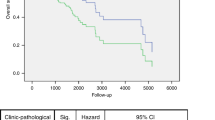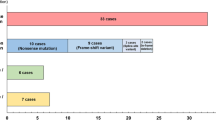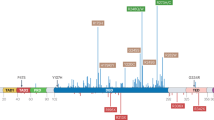Abstract
In order to isolate experimentally induced p53 mutations, a yeast expression vector harbouring a human wild-type p53 cDNA was treated in vitro with the antineoplastic drug chloroethyl-cyclohexyl-nitroso-urea (CCNU) and transfected into a yeast strain containing the ADE2 gene regulated by a p53-responsive promoter. p53 mutations were identified in 32 out of 39 plasmids rescued from independent ade- transformants. Ninety-two percent of CCNU induced mutations were GC-targeted single base pair substitutions, and GC>AT transitions represented 73% of all single base pair substitutions. In 70% of the cases the mutated G was preceded 5′ by a purine. The distribution of the mutations along the p53 cDNA was not random: positions 734 and 785 appeared as CCNU mutational hotspots (n=3, P<0.0003) and CCNU induced only GC>AT transitions at those positions. The features of these CCNU-induced mutations are consistent with the hypothesis that O6-alkylguanine is the major causative lesion. One third of the CCNU-induced mutants were absent from a huge collection of 4496 p53 mutations in human tumours and cell lines, thus demonstrating that CCNU has a mutational spectrum which is uniquely different from that of naturally selected mutations. This strategy allows direct comparison of observed natural mutation spectra with experimentally induced mutation spectra and opens the way to a more rigorous approach in the field of molecular epidemiology.
This is a preview of subscription content, access via your institution
Access options
Subscribe to this journal
Receive 50 print issues and online access
269,00 € per year
only 5,38 € per issue
Buy this article
- Purchase on SpringerLink
- Instant access to full article PDF
Prices may be subject to local taxes which are calculated during checkout
Similar content being viewed by others
Author information
Authors and Affiliations
Rights and permissions
About this article
Cite this article
Inga, A., Iannone, R., Monti, P. et al. Determining mutational fingerprints at the human p53 locus with a yeast functional assay: a new tool for molecular epidemiology. Oncogene 14, 1307–1313 (1997). https://doi.org/10.1038/sj.onc.1200952
Received:
Revised:
Accepted:
Issue Date:
DOI: https://doi.org/10.1038/sj.onc.1200952
Keywords
This article is cited by
-
Yeast-based genotoxicity tests for assessing DNA alterations and DNA stress responses: a 40-year overview
Applied Microbiology and Biotechnology (2018)
-
The role of p53 as a surrogate marker for chemotherapeutical responsiveness in ovarian cancer
Journal of Cancer Research and Clinical Oncology (2010)
-
Characterization of the p53 mutants ability to inhibit p73β transactivation using a yeast-based functional assay
Oncogene (2003)
-
Tumour p53 mutations exhibit promoter selective dominance over wild type p53
Oncogene (2002)
-
Determination of optimal conditions for analysis of p53 status in leukemic cells using functional analysis of separated alleles in yeast
Pathology & Oncology Research (2002)



